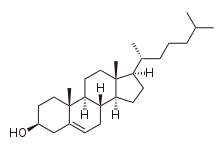Triterpenes are a class of terpenes composed of six isoprene units with the molecular formula C30H48; they may also be thought of as consisting of three terpene units. Animals, plants and fungi all produce triterpenes, including squalene, the precursor to all steroids.[1][2]
YouTube Encyclopedic
-
1/3Views:11 7959131 275
-
General Introduction to Steroids and Triterpenoids (Part 1) By Solution Pharmacy (HINDI)
-
Chemical Identification Test for Steroids & Triterpenoids: GPAT, Pharmacist & other Exam Exclusive
-
Extraction, isolation, identification and characterization of Phytoconstitutents
Transcription
Structures
Triterpenes exist in a great variety of structures. Nearly 200 different skeletons have been identified.[3] These skeletons may be broadly divided according to the number of rings present. In general pentacyclic structures (5 rings) tend to dominate.
| Number of rings | Examples |
|---|---|
| 0 | Squalene |
| 1 | Achilleol A [4] |
| 2 | Polypodatetraene |
| 3 | Malabaricane |
| 4 | Lanostane, Cucurbitacin |
| 5 | Hopane, Oleanane, Ursolic acid |
| 6 | Chamaecydin |
Squalene is biosynthesized through the head-to-head condensation of two farnesyl pyrophosphate units. This coupling converts a pair of C15 components into a C30 product. Squalene serves as precursor for the formation of many triterpenoids, including bacterial hopanoids and eukaryotic sterols.
Triterpenoids

By definition triterpenoids are triterpenes that possess heteroatoms, usually oxygen. The terms triterpene and triterpenoid often are used interchangeably.
Triterpenoids possess a rich chemistry and pharmacology (e.g. cholesterol) with several pentacyclic motifs. Lupane, oleanane and ursane show particular promise as anti-cancer agents.[5][6]
Steroids
Steroids feature a cucurbitane core, although in practice they are biosynthesised from either lanosterol (animals and fungi) or cycloartenol (plants) via the cyclization of squalene. Steroids have two principal biological functions, being either key components of cell membranes or signaling molecules that activate steroid hormone receptors. Important sub-classes include sterols and cucurbitacins.
Triterpenoid saponins
Triterpenoid saponins are triterpenes which belong to the saponin group of compounds, making them triterpenoid glycosides. They are produced by plants as part of their self-defense mechanism[7] with important sub-classes including ginsenosides[8] and eleutherosides.
References
- ^ Eberhard Breitmaier (2006). "Triterpenes". Terpenes: Flavors, Fragrances, Pharmaca, Pheromones. pp. 86–108. doi:10.1002/9783527609949.ch6. ISBN 9783527609949.
- ^ Davis, Edward M.; Croteau, Rodney (2000). "Cyclization Enzymes in the Biosynthesis of Monoterpenes, Sesquiterpenes, and Diterpenes". Topics in Current Chemistry. 209: 53–95. doi:10.1007/3-540-48146-X_2. ISBN 978-3-540-66573-1.
- ^ Xu, Ran; Fazio, Gia C.; Matsuda, Seiichi P.T. (February 2004). "On the origins of triterpenoid skeletal diversity". Phytochemistry. 65 (3): 261–291. doi:10.1016/j.phytochem.2003.11.014. PMID 14751299.
- ^ Barrero, A.F.; Alvarez-Manzaneda, E.J.R.; Alvarez-Manzaneda r, R. (1989-01-01). "Achilleol A: A new monocyclic triterpene skeleton from Achillea odorata L." Tetrahedron Letters. 30 (25): 3351–3352. doi:10.1016/S0040-4039(00)99242-6. ISSN 0040-4039.
- ^ Laszczyk, Melanie (2009). "Pentacyclic Triterpenes of the Lupane, Oleanane and Ursane Group as Tools in Cancer Therapy". Planta Medica. 75 (15): 1549–60. doi:10.1055/s-0029-1186102. PMID 19742422.
- ^ Liu, Jie (December 1995). "Pharmacology of oleanolic acid and ursolic acid". Journal of Ethnopharmacology. 49 (2): 57–68. doi:10.1016/0378-8741(95)90032-2. PMID 8847885.
- ^ Augustin, Jörg M.; Kuzina, Vera; Andersen, Sven B.; Bak, Søren (April 2011). "Molecular activities, biosynthesis and evolution of triterpenoid saponins". Phytochemistry. 72 (6): 435–457. doi:10.1016/j.phytochem.2011.01.015. PMID 21333312.
- ^ Attele, Anoja S; Wu, Ji An; Yuan, Chun-Su (December 1999). "Ginseng pharmacology". Biochemical Pharmacology. 58 (11): 1685–1693. doi:10.1016/S0006-2952(99)00212-9. PMID 10571242.

